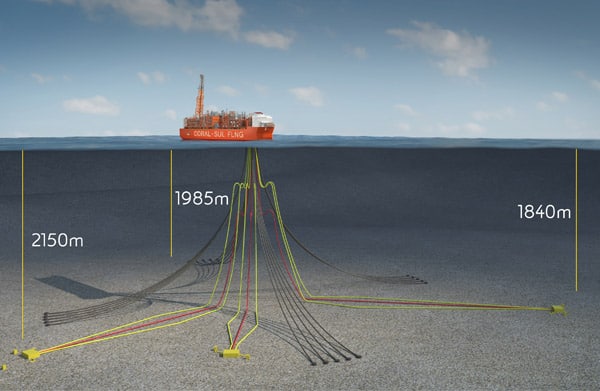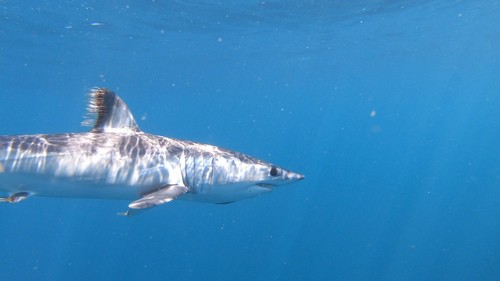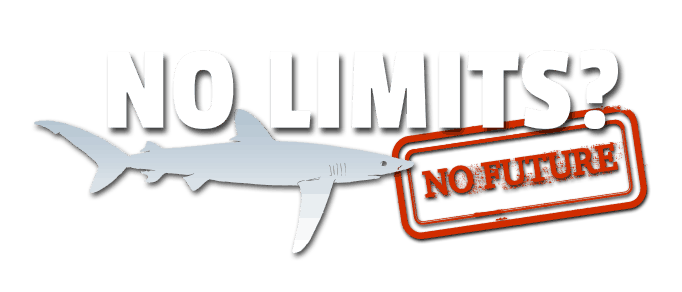Industry leading mooring solutions supplier, SOFEC, Inc., has selected BMT and Sonardyne Inc., under their teaming agreement, to supply an innovative mooring monitoring system (MMS) for a major new deepwater development.
The new system will involve monitoring of the turret mooring system on a new-build floating liquefied natural gas (FLNG) facility being built in South Korea for ENI’s Coral South project offshore Mozambique. With water depths ranging from 1,500-2,300 metres, SOFEC, a MODEC Group company, wanted to integrate a robust and reliable MMS to complement their market leading turret mooring solution.

SOFEC chose to use BMT and Sonardyne’s combined engineering strength in order to acquire the most technically competent and robust MMS. Their selection was based on high data availability, ease of remote operated vehicle (ROV) installation, robustness of the subsea technology and the longevity between maintenance periods that the BMT / Sonardyne MMS offers, compared with other solutions in the market.
Above the waterline, BMT will supply the station-keeping turret monitoring system and local control panel with touchscreen interface. The control panel will also house Sonardyne’s topside equipment, to minimise the system’s footprint. Additionally, the system will allow SOFEC’s client to gain remote data access through BMT’s secure cloud-based portal, BMT DEEP.
Below the waterline, Sonardyne’s SMART (Subsea Monitoring, Analysis and Reporting Technology) will be used to constantly monitor mooring integrity on each of the 20 anchor legs. Daily summary reports and automatic fault detections will be wirelessly communicated to the surface from the SMARTs real-time.
[blockquote author=” Robert Barker, Offshore Commercial Manager at BMT”]”We are proud to be supporting SOFEC with this work and the Coral MMS project represents a significant contract award. Our system will be providing valuable integrity data and important real-time monitoring of the mooring system to enhance operational safety.”[/blockquote]
Stephen Auld, Global Business Manager, Subsea Asset Monitoring, Sonardyne, says, “Our SMARTs use fast burst and highly energy efficient acoustic telemetry, as well as ultra-low power electronics, reducing through-life costs for customers, and that was a real positive for SOFEC. For this project, we’ve also increased the time between battery replacement to in excess of six years, so it’s a long-life, easy to use system to ensure integrity data acquisition.”
We’re a long-term corporate patron of leading UK-based charity the Shark Trust, supporting its work globally to preserve the world’s shark populations. Ahead of World Oceans Day on Saturday, we invited the Shark Trust Managing Director Paul Cox to tell us – and you – about some of the issues the charity is addressing.
Author: Paul Cox, Managing Director, Shark Trust
 That plastic straw thing. It has a peculiar ability to both delight and dismay in equal measure. Coming from someone who spends their working life dedicated to marine conservation, how can a ban on plastic straws be anything but a good thing?
That plastic straw thing. It has a peculiar ability to both delight and dismay in equal measure. Coming from someone who spends their working life dedicated to marine conservation, how can a ban on plastic straws be anything but a good thing?
It’s great that a big sustainability issue has made it into the “mainstream” – using a plastic straw has gone from unremarkable to almost socially unacceptable in little over a year. But it feels to me a bit like misdirection. The future of our oceans doesn’t, sadly, hinge on banning plastic straws.
My hope is that the straw will become an icon, a symbol of the willingness to change. It’s not the conclusion of the story, but the beginning of a new chapter in how we deal with the ocean to which we owe so much.
An immediate threat

Alongside the plastic problem, there’s another, more immediate threat which isn’t getting the bandwidth that it deserves. And that’s overfishing. It’s not a complicated equation. We all know that if we spend more than we earn, things are going to go badly. You can get away with it for a while but ultimately, if you make a habit of it, then at some point you’ll get into trouble.
This problem is at the heart of overfishing. Think of the sea as a savings account. We inherited a lump sum which, as the fish reproduce, pays interest. Withdraw some or all of that interest and your nest egg is safe. Take more and your savings start to shrink. When your savings shrink so does your interest.
In amongst that inheritance are some priceless antiques of nature: Sharks. They’ve been in the oceans for more than 400 million years and include some of the most vital, valuable and vulnerable species in our seas.
At risk of extinction
Sharks are also particularly vulnerable to overfishing. They’re slow and thrifty at reproducing. They pay a low rate of “interest”, so they should be fished with caution. But they’re not. They’re being taken in high numbers and, for too many species, at a rate beyond their ability to replace themselves. The last comprehensive analysis by the International Union for Conservation of Nature (IUCN) Red List of Threatened Species estimated that over a quarter of the 1000+ species of sharks and rays that exist are at risk of extinction. This includes some of the most well-known and well-loved sharks.
If we’re to avoid bankruptcy, we need to act fast. The Shark Trust is the UK charity that works globally to safeguard the future of sharks and rays. Transforming fisheries to sustainability is a core goal and the we work with a range of international partners to achieve positive change.
Through various projects and campaigns the we’ve been a leader for more than 20 years in taking a sensible line on shark conservation and always placing science at the heart of decision-making. Our work cuts across governments, policymakers, industry and businesses. We find constructive solutions and drive best practice wherever sharks and people meet.
Targeting uncontrolled shark fisheries

Our No Limits? campaign targets an end to uncontrolled shark fisheries – in Europe and on the high seas. We’re determined that shark fisheries should implement science-based catch limits to prevent continued overfishing.
The plight of the Shortfin Mako – the world’s fastest shark – demonstrates the importance of this effort. This stunning shark, recently re-assessed as Endangered by the IUCN, has been heavily overfished in the Atlantic. In 2017, scientists estimated that, even if catches were cut to zero, North Atlantic Shortfin Makos would only have a 54% chance of recovery by 2040. Despite this dire prediction and the clear need for a prohibition, the species continues to be fished. Despite a red letter from the bank, the spending continues.
It’s not either/or. Overfishing, climate change, plastics and other issues work hand in hand. If populations are stressed by continued overfishing then they lack the resilience that they might otherwise have to deal with a changing environment. There is no single solution to safeguarding the world’s oceans, but tackling overfishing is an urgent priority.
We are making progress, but we need to keep pushing. We’re committed to bringing as many people to the party as possible. We’re grateful for Sonardyne’s ongoing support, reflecting their vision and positive attitude towards sustainable use of our oceans. Everyone can get involved and everyone can be a positive influence on the future of sharks.
Find out more about sharks and how you can get involved www.sharktrust.org/getinvolved
Images:
Shortfin Mako shark, copyright Nicolas Authier (CC BY-NC), https://www.inaturalist.org/photos/35510241
Shortfin Mako shark, copyright Alison Kock (CC BY-NC), https://www.inaturalist.org/photos/37399944
Leading seismic monitoring instrumentation and solutions provider Güralp Systems Ltd. and Sonardyne International Ltd. have signed an agreement to cooperate in the provision of cutting edge multidisciplinary ocean bottom research technology, including capabilities for earthquake or tsunami detection.
The official Teaming Agreement between Güralp and Sonardyne, announced at the European Association of Geoscientists and Engineers (EAGE) conference in London today (June 4), will enable the two companies to collaboratively provide more advanced and efficient technology for in-situ seismic and seabed monitoring.
Güralp has more than 30 years’ experience in the design and manufacture of broadband seismometers and accelerometers, while Sonardyne’s experiences stretches to more than 40 years of experience in long-endurance data collection and through-water telemetry. As a consequence, clients globally will benefit from a combined offering of technology for seismic data gathering, seabed deformation monitoring and tsunami detection, as well integrated acoustic positioning and telemetry for remote data access.
At the heart of the cooperation is Güralp’s revolutionary new Aquarius Ocean Bottom Seismometer (OBS). Comprising of a digital feedback tri-axial broadband seismometer, three-axis magnetometer, a micro-electric mechanical system (MEMS) accelerometer and absolute pressure gauge, Aquarius is also equipped with Sonardyne’s 6G Wideband low-mid frequency (LMF) acoustics.
The low profile and compact design of the Aquarius minimises flow noise, but also makes it the most compact telemetry-enabled OBS available in the market. Available in two variants, the Aquarius is capable of 12 or 18 month deployments depending on the system options selected. These options include instrument configuration, transmission of state of health and triggered event or snippet data transmission at up to 9,000 bps.
6G-inside capability also means that Aquarius is compatible with a range of other Sonardyne technologies, including Ranger 2 Ultra-Short BaseLine (USBL) positioning and telemetry, as well as its unmanned surface vehicle (USV) GPS-Acoustic payload box and Tsunami Detection System.
Both companies have global reputations for provision of class-leading technology to academic, public, governmental and private organisations for understanding and exploring our world. As a consequence Güralp and Sonardyne are confident that closer cooperation will lead to a further step-change in the solutions available to customers.
Geraint West, Global Business Manager, Ocean Sciences, Sonardyne, says, “We really welcome closer cooperation with Güralp. Our overlapping markets and complementary technologies mean that we have the potential to transform what we can individually offer to our customers.”
[blockquote author=” Neil Watkiss, Commercial Director, Güralp”]”The Sonardyne technology that we are utilising in the Aquarius is allowing us to re-define what is possible with broadband OBS. This agreement offers potential for further exciting product advancements on both sides and we look forward to further exploring the possibilities with the Sonardyne team.”[/blockquote]
You can find Sonardyne on stand 855 during EAGE (June 3-6).